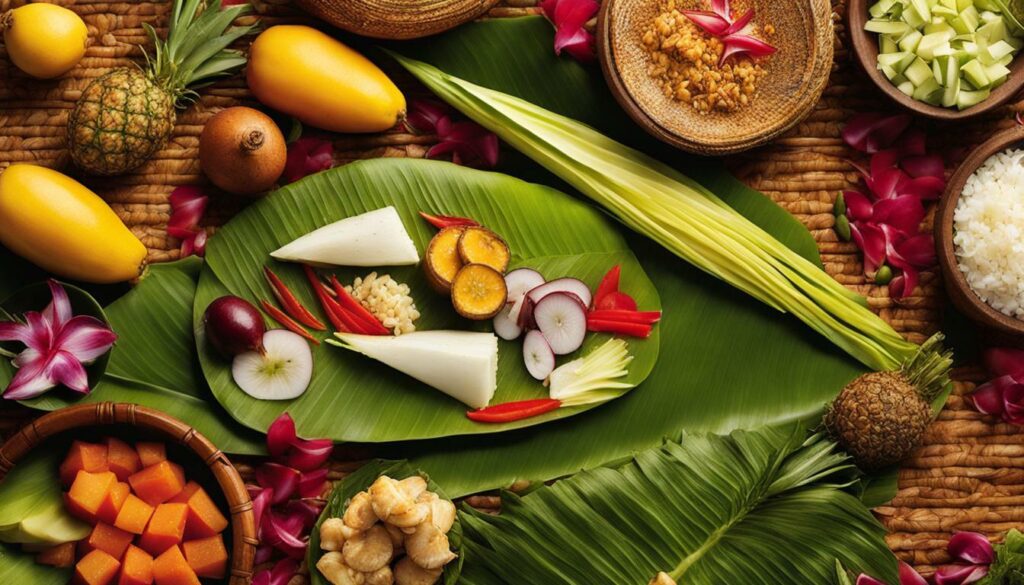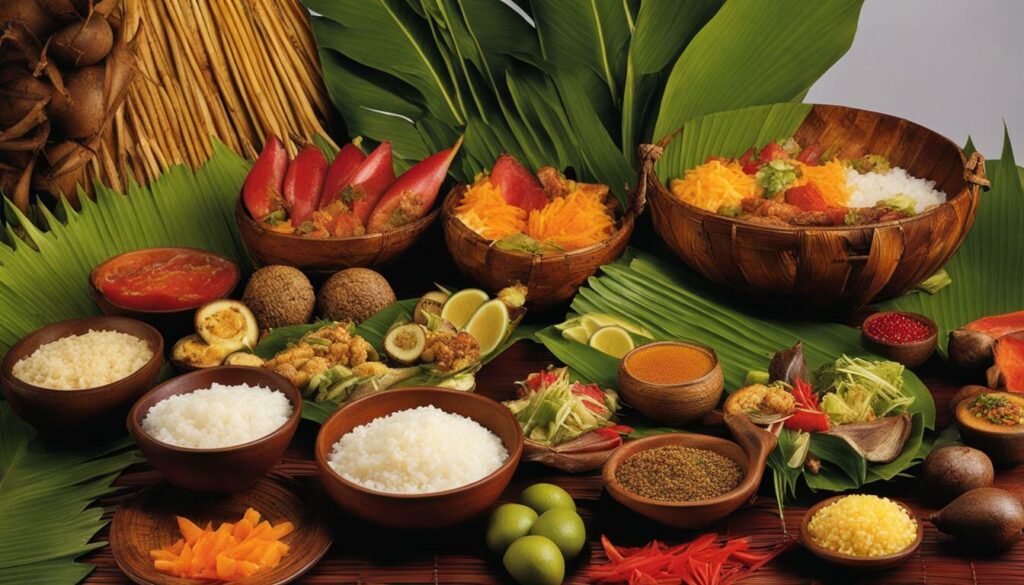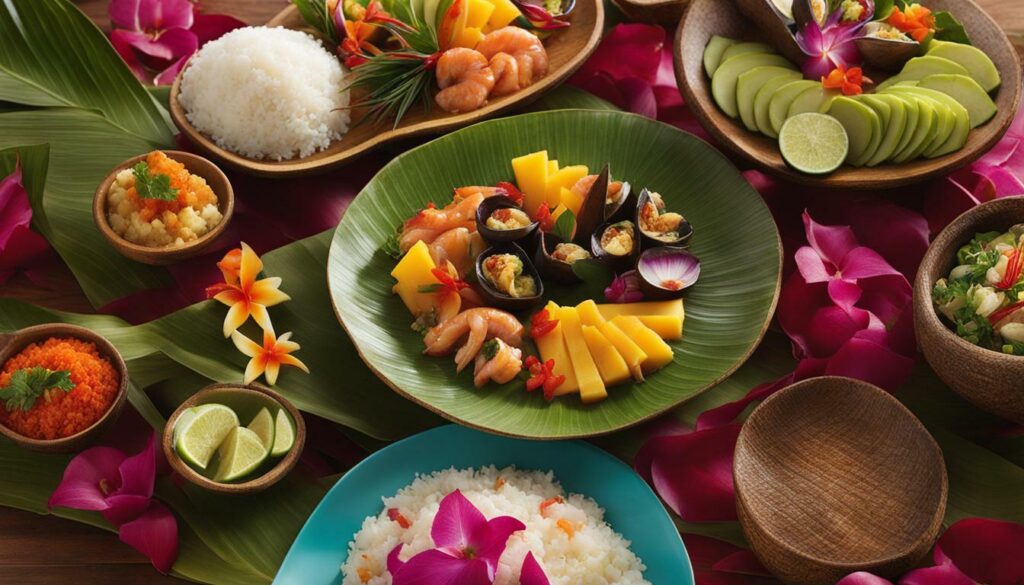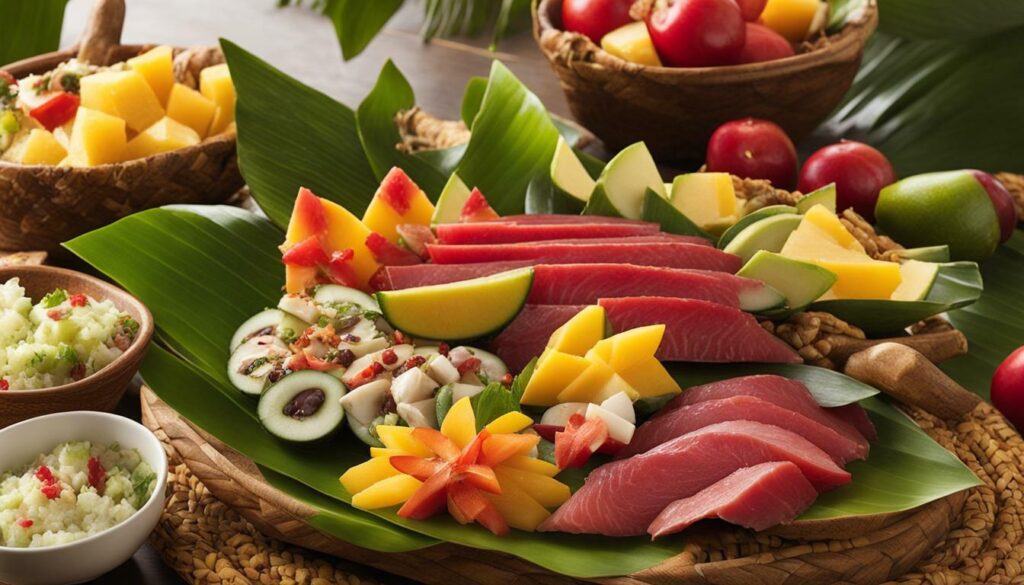Polynesian cuisine has a rich history, with both past and present diets offering unique insights into the region’s food culture. The diets of Polynesia have evolved over time, blending traditional and modern influences. In the past, Polynesians relied on crops like yams, taro, breadfruit, bananas, coconuts, and Tahitian chestnuts. These foods provided nutrients, and their preparation methods, such as pit-roasting and stewing, retained their natural flavours. Traditional Polynesian meals included fish, seafood, and pork, seasoned with ginger, lime, garlic, and coconut oil. However, the introduction of Western foods has led to a transition to a more processed and imported diet, resulting in a rise in obesity and chronic diseases like heart disease and diabetes. Efforts are being made to encourage a return to traditional diets and lifestyles.
Key Takeaways
- The diets of Polynesia have evolved over time, incorporating both traditional and modern influences.
- Traditional Polynesian foods include yams, taro, breadfruit, bananas, coconuts, and Tahitian chestnuts.
- Pit-roasting and stewing are traditional cooking methods that help retain the natural flavours of Polynesian foods.
- Traditional Polynesian meals often feature fish, seafood, and pork seasoned with ginger, lime, garlic, and coconut oil.
- The introduction of Western foods has resulted in a shift towards a more processed and imported diet, leading to health concerns like obesity and chronic diseases.
- Efforts are underway to promote a return to traditional diets and lifestyles in Polynesia for better health outcomes and cultural preservation.
Historical Diets in Polynesia
The historical diets of Polynesia were heavily influenced by the region’s abundant natural resources and cultural practices. Polynesians relied on crops such as yams, taro, breadfruit, bananas, coconuts, and Tahitian chestnuts, which provided essential nutrients and sustained their communities for generations. These staple foods were harvested from the land and sea and prepared using traditional cooking methods that preserved their natural flavours.
Traditional Polynesian meals often featured fish, seafood, and pork, seasoned with herbs and spices like ginger, lime, garlic, and coconut oil. The combination of fresh ingredients and aromatic flavours created unique and delicious dishes that showcased the diversity of Polynesian cuisine. Polynesians practised sustainable fishing and farming techniques, ensuring the sustainability of their food sources and respecting the natural environment.
“The traditional diets of Polynesians were a testament to the rich culinary heritage and resourcefulness of the region’s people. Their deep connection to the land and sea resulted in a diet that provided both sustenance and pleasure.”
However, the introduction of Western foods and influences has brought about significant changes in Polynesian diets. With the arrival of European explorers and settlers, new ingredients, cooking techniques, and culinary traditions were introduced. This led to a transition to a more processed and imported diet, which has had adverse effects on the health and well-being of Polynesian communities.

| Traditional Polynesian Foods | Methods of Preparation |
|---|---|
| Fish and Seafood | Grilled, steamed, or baked |
| Pork | Pit-roasted or stewed |
| Yams, Taro, Breadfruit, Bananas, Coconuts, Tahitian Chestnuts | Boiled, mashed, or roasted |
As a result, Polynesia has seen a rise in obesity rates and the prevalence of chronic diseases like heart disease and diabetes. Recognizing the importance of their cultural heritage and the need for better health outcomes, efforts are being made to encourage a return to traditional diets and lifestyles. These initiatives emphasize the consumption of fresh, locally sourced foods and the revival of traditional cooking practices, ensuring the preservation of Polynesian culinary traditions for future generations.
Traditional Foods in Polynesia
Polynesians relied on a variety of traditional foods such as yams, taro, breadfruit, and coconuts, which provided essential nutrients and flavours to their meals. These staple ingredients formed the foundation of Polynesian cuisine and played a significant role in the cultural and culinary heritage of the region.
The Polynesians’ close relationship with nature allowed them to harness the abundance of resources available on their islands. They cultivated yams and taro in carefully tended gardens, utilizing their starchy roots in a range of dishes. Breadfruit, with its versatile nature and bread-like texture, was another important crop that sustained Polynesian communities. Coconuts were highly valued for their meat, milk, and oil, adding richness and depth to traditional Polynesian recipes.
Preparation methods also played a vital role in preserving the natural flavours of these ingredients. Polynesians employed traditional cooking techniques such as pit-roasting, which involved slow-cooking food over an open fire, resulting in tender and flavorful meals. Stewing was another common method, allowing the flavours to meld together and create delicious, hearty dishes.
Sample Traditional Polynesian Recipe:
One popular traditional Polynesian dish is Umu Kuka, a slow-cooked feast prepared in an earth oven called an umu. In this dish, a variety of ingredients such as pork, chicken, fish, and vegetables are wrapped in banana leaves and placed on hot stones inside the umu. The meal is then covered with more banana leaves and left to cook for several hours. The result is a flavorful and tender dish that showcases the unique cooking methods and flavours of Polynesian cuisine.

| Ingredients | Instructions |
|---|---|
|
|
Traditional Polynesian recipes like Umu Kuka are a testament to the rich culinary heritage of the Pacific Islands. These dishes not only showcase the unique flavours and techniques of Polynesian cuisine but also reflect the deep connection of the Polynesian people to their natural surroundings. While modern influences have impacted the diets of Polynesia, efforts are being made to preserve and promote traditional foods, recognizing their importance in maintaining cultural identity and overall well-being.
Evolution of Polynesian Diets
The diets of Polynesia have undergone significant changes throughout history, with the introduction of Western foods leading to the evolution of modern-day cuisines in the region. In the past, Polynesians relied on a variety of foods grown locally, such as yams, taro, breadfruit, bananas, coconuts, and Tahitian chestnuts. These staple ingredients provided essential nutrients and were prepared using traditional methods, which preserved their natural flavours.
Traditional Polynesian meals often consisted of fish, seafood, and pork, seasoned with ingredients like ginger, lime, garlic, and coconut oil. The fish and seafood were typically cooked by grilling or steaming, while pork was roasted in underground ovens called “umu” or “hangi.” The use of these cooking techniques not only added flavour to the dishes but also retained the nutritional value of the ingredients.
However, with the arrival of Europeans to the Polynesian islands, there was a gradual introduction of Western foods, including processed foods and ingredients, such as sugar, flour, and canned goods. This shift in dietary preferences and practices has had a significant impact on the health of the Polynesian population. The increased consumption of processed and imported foods has contributed to a rise in obesity rates and the prevalence of chronic diseases like heart disease and diabetes.
Recognizing the negative consequences of these dietary changes, there has been a growing movement to promote a return to traditional diets and lifestyles in Polynesia. Efforts are being made to educate and encourage individuals to incorporate more fresh, local, and traditional foods into their diets. By embracing their culinary heritage and emphasizing the importance of wholesome, nutrient-rich ingredients, Polynesians can strive for better health outcomes and preserve their cultural traditions.

| Traditional Foods | Modern Adaptations |
|---|---|
| Yams | French fries |
| Taro | Taro chips |
| Breadfruit | Breadfruit pizza crust |
| Bananas | Banana bread |
| Coconuts | Coconut milk ice cream |
“We must preserve our cultural heritage and embrace the wisdom of our ancestors by prioritizing traditional foods that nourish our bodies and sustain our communities.” – Polynesian Food Advocate
The Importance of Balancing Tradition and Adaptation
While it is necessary to acknowledge and adapt to the realities of the modern world, it is equally important to maintain a connection to one’s cultural roots. Balancing tradition and adaptation can help Polynesians create a sustainable and healthy food culture that honours their heritage.
- Take inspiration from traditional recipes and adapt them to include more nutrient-dense and locally sourced ingredients.
- Support local farmers and artisans who cultivate and produce traditional foods.
- Promote community initiatives that educate individuals about the benefits of traditional diets and lifestyles.
By promoting a return to traditional diets and embracing the evolution of Polynesian cuisines, Polynesians can navigate the challenges of the modern world while preserving their cultural identity and fostering better health outcomes for future generations.
Popular Polynesian Dishes
Polynesia is known for its vibrant culinary traditions, with popular dishes like fish, seafood, and pork seasoned with ginger, lime, garlic, and coconut oil. These flavorful ingredients are the building blocks of Polynesian cuisine, reflecting the region’s rich cultural heritage and diverse food culture.
One iconic Polynesian dish is Po’e, a delicious dessert made from mashed bananas, grated coconut, and a hint of vanilla. It is traditionally steamed and served with a drizzle of coconut cream. This sweet treat showcases the use of natural ingredients and highlights the importance of coconuts in Polynesian cooking.
An absolute must-try is the famous Poke Bowl. This popular dish combines fresh marinated fish, typically tuna or salmon, with various toppings such as avocado, cucumber, and seaweed. It is a healthy and flavorful dish that perfectly represents the fusion of traditional and modern influences in Polynesian cuisine.
| Popular Polynesian Dishes | Description |
|---|---|
| Po’e | A traditional Polynesian dessert made from mashed bananas, grated coconut, and vanilla. |
| Poke bowl | A fresh and vibrant dish featuring marinated fish with toppings such as avocado, cucumber, and seaweed. |
Polynesian Food Culture
Polynesian cuisine is not only about the food itself, but also about the cultural significance and communal aspect of dining. Sharing meals with family and friends is an integral part of the Polynesian food culture, fostering a sense of connection and togetherness.
Polynesian culinary traditions go beyond individual dishes and extend to the way food is prepared and consumed. Traditional cooking methods like pit-roasting and stewing are still practised, allowing the natural flavours of the ingredients to shine through. These methods have been passed down through generations, preserving the authenticity of Polynesian cuisine.
As Polynesia continues to embrace its cultural heritage, efforts are being made to promote sustainable and locally sourced ingredients. Supporting local farmers and artisans not only helps preserve traditional farming practices but also ensures the authenticity and quality of the food.

In conclusion, the popularity of Polynesian dishes stems from the unique blend of flavours, the emphasis on fresh ingredients, and the cultural significance of communal dining. Whether it’s enjoying a traditional dessert like Po’e or indulging in the vibrant flavours of a Poke bowl, the rich culinary traditions of Polynesia offer a feast for the senses.
Dietary Habits in Polynesia
Polynesian dietary practices involve a variety of staple foods and traditional cooking techniques that have been passed down through generations. These practices are deeply rooted in the culture and have played a significant role in the health and well-being of Polynesians for centuries.
Staple foods in Polynesia include yams, taro, breadfruit, bananas, coconuts, and Tahitian chestnuts. These nutrient-rich crops form the foundation of traditional Polynesian meals, providing essential vitamins, minerals, and fibre. Polynesians have developed unique cooking methods to maximize the flavour and nutritional value of these foods, such as pit-roasting, steaming, and stewing.
Traditional Polynesian meals often feature a combination of fish, seafood, and pork, seasoned with local ingredients like ginger, lime, garlic, and coconut oil. These ingredients not only enhance the taste of the dishes but also add medicinal properties that have been valued for their health benefits.
| Staple Foods | Cooking Techniques | Seasonings |
|---|---|---|
| Yams | Pit-roasting, steaming | Ginger, lime |
| Taro | Boiling, baking | Garlic, coconut oil |
| Breadfruit | Grilling, frying | Coconut milk |
| Bananas | Boiling, mashing | Cinnamon, honey |
However, the dietary landscape in Polynesia has undergone significant changes in recent years. The introduction of Western foods, high in refined sugars, processed fats, and additives, has led to a shift towards a more processed and imported diet. This transition has had an adverse impact on the health of Polynesians, contributing to the rise in obesity and the prevalence of chronic diseases like heart disease and diabetes.
Recognizing the importance of preserving traditional diets and cultural heritage, efforts are being made to promote a return to these traditional eating practices. By embracing the staple foods and cooking techniques of Polynesia, individuals can reap the nutritional benefits and support their overall well-being. Encouraging a balance between tradition and adaptation is vital to safeguard the health and cultural identity of Polynesia.

| Health Benefits of Traditional Polynesian Foods and Cooking Techniques |
|---|
| High in essential vitamins, minerals, and fibre |
| Rich source of omega-3 fatty acids from fish and seafood |
| Natural antioxidants from local herbs and spices |
| Medicinal properties of ginger, garlic, and coconut oil |
Modern Adaptations and Health Concerns
The introduction of modern food practices and imported ingredients has brought about changes in Polynesian cuisine, leading to health concerns such as obesity and chronic diseases. Traditional Polynesian diets were rich in nutrient-dense foods like yams, taro, breadfruit, bananas, coconuts, and Tahitian chestnuts, which provided essential vitamins and minerals. These foods were prepared using traditional cooking methods that retained their natural flavours and nutritional value. However, the influence of Western foods has led to a shift towards processed and imported ingredients, resulting in a decline in the consumption of traditional staples.
This dietary transition has had significant health consequences for the Polynesian population. The increased availability of processed foods, high in sugar, fat, and salt content, has contributed to a rise in obesity rates. According to a study conducted by the World Health Organization, the prevalence of obesity in Polynesia is among the highest in the world, with approximately 75% of adults being classified as overweight or obese.
Health Consequences of Modern Diets
The adoption of modern diets has also been linked to an increase in chronic diseases such as heart disease and diabetes. The excessive consumption of refined carbohydrates and sugary beverages has contributed to the development of insulin resistance and obesity-related conditions. Additionally, the shift away from traditional cooking methods, such as pit-roasting and stewing, has led to a reduction in the intake of nutrient-rich, unprocessed foods.
| Health Concerns | Impact |
|---|---|
| Obesity | High prevalence, contributing to various health problems |
| Heart disease | Increased risk due to high intake of processed foods |
| Diabetes | Rising incidence due to excessive consumption of refined carbohydrates |
To address these health concerns, there have been growing efforts to promote a return to traditional Polynesian diets and lifestyles. Organizations and community initiatives are providing education on the benefits of consuming locally sourced, unprocessed foods and reviving traditional cooking techniques. By reconnecting with their culinary heritage, Polynesians aim to improve their overall health and preserve their cultural identity.

Efforts Towards a Return to Tradition
Recognizing the importance of traditional diets and cultural practices, initiatives are being taken to reintroduce traditional foods and promote healthier lifestyles in Polynesia. These efforts aim to revive the Polynesian culinary tradition and address the health concerns associated with the modernization of diets in the region.
One such initiative is the promotion of traditional food crops like yams, taro, breadfruit, and bananas. These nutrient-rich staple ingredients were once the backbone of Polynesian diets, providing essential vitamins, minerals, and fibre. By reintroducing these traditional crops, Polynesians are rediscovering the flavours and nutritional benefits of their ancestral foods.
In addition to promoting traditional crops, there is a renewed focus on traditional cooking methods. Polynesian communities are reviving ancient techniques such as pit-roasting and stewing, which allow the natural flavours of the ingredients to shine. By embracing these traditional cooking methods, Polynesians are not only preserving their culinary heritage but also promoting healthier cooking practices.
The return to tradition goes beyond food alone. Polynesians are also embracing traditional lifestyles that prioritize physical activity and connection with nature. Traditional practices like fishing, farming, and canoeing are being revitalized, encouraging a more active and sustainable way of life. These efforts not only contribute to improved health but also promote a deeper connection to cultural roots.
Table: Traditional Polynesian Foods
| Food | Description |
|---|---|
| Taro | A starchy root vegetable widely used in Polynesian cuisine. |
| Breadfruit | A versatile fruit with a potato-like texture, often roasted or steamed. |
| Coconut | A tropical fruit used for its milk, oil, and meat in various dishes. |
| Tahitian Chestnut | A nut-like seed commonly used in desserts and snacks. |
| Fish | A staple source of protein in Polynesian diets, often cooked with traditional seasonings. |
| Pork | A popular meat choice, often enjoyed during special occasions and feasts. |

Efforts towards a return to tradition are driven by a desire to reclaim Polynesia’s unique food culture and address the health challenges faced by the community. By reintroducing traditional foods, reviving culinary techniques, and embracing traditional lifestyles, Polynesians are working towards a healthier and more sustainable future.
Conclusion
The past and present diets of Polynesia reflect a rich culinary history that has evolved over time, with traditional foods and practices still holding significant cultural and nutritional value.
In the past, Polynesians relied on crops such as yams, taro, breadfruit, bananas, coconuts, and Tahitian chestnuts. These staple foods provided essential nutrients and were prepared using traditional methods like pit-roasting and stewing, which retained their natural flavours.
Traditional Polynesian meals consisted of fish, seafood, and pork, seasoned with ginger, lime, garlic, and coconut oil. The combination of these flavours created unique and delicious dishes that highlighted the region’s culinary heritage.
However, the introduction of Western foods has led to a shift in Polynesian diets, resulting in a transition to a more processed and imported diet. This transformation has brought about a rise in obesity and chronic diseases such as heart disease and diabetes.
To combat these health concerns and preserve their cultural heritage, there are ongoing efforts to encourage a return to traditional diets and lifestyles in Polynesia. By promoting the consumption of traditional foods and adopting healthier cooking methods, Polynesian communities aim to improve their overall well-being and reconnect with their culinary roots.
The past and present diets of Polynesia highlight the importance of finding a balance between tradition and adaptation. By valuing and preserving their rich culinary history, Polynesians can ensure that future generations continue to benefit from the cultural and nutritional value of their traditional foods.
FAQ
What were the traditional foods in Polynesia?
Traditional Polynesian diets included staple foods such as yams, taro, breadfruit, bananas, coconuts, and Tahitian chestnuts. These nutritious crops formed the basis of Polynesian meals.
How were traditional Polynesian meals prepared?
Traditional Polynesian meals were often prepared using methods like pit-roasting and stewing, which helped retain the natural flavours of the foods. This cooking style enhanced the taste and nutritional value of the dishes.
What were the seasonings used in traditional Polynesian cooking?
Traditional Polynesian meals were seasoned with ingredients like ginger, lime, garlic, and coconut oil. These seasonings added depth and flavour to the dishes, complementing the natural taste of the ingredients.
How have Polynesian diets evolved over time?
Polynesian diets have undergone changes with the introduction of Western foods. This has led to a transition to a more processed and imported diet, resulting in health issues like obesity and chronic diseases.
What are some popular Polynesian dishes?
Popular Polynesian dishes include various seafood and fish preparations, along with pork dishes. Traditional recipes like poke, lomi lomi salmon, and kalua pig are well-known examples of Polynesian cuisine.
What are the dietary habits in Polynesia?
Polynesian dietary habits often include the consumption of staple foods like taro, yams, fish, and coconuts. These foods provide essential nutrients and are an integral part of the traditional Polynesian diet.
What health concerns are associated with modern Polynesian diets?
The shift towards a more processed and imported diet in Polynesia has led to health concerns such as obesity, heart disease, and diabetes. These chronic diseases are linked to the consumption of less nutritious and more processed foods.
What efforts are being made to promote traditional diets in Polynesia?
Efforts are being made to encourage a return to traditional diets and lifestyles in Polynesia. These efforts aim to improve health outcomes and preserve the cultural heritage associated with Polynesian cuisine.
Source Links
- https://www.britannica.com/place/Polynesia/Gardening
- https://polynesia.com/blog/explore-authentic-polynesian-food-in-hawaii
- https://www.encyclopedia.com/food/news-wires-white-papers-and-books/pacific-islanders-diet
Read Our Articles On The Other Regions of Oceania Here:
| Past and Present Diets of Australasia |
| Past and Present Diets of Melanesia |
| Past and Present Diets of Micronesia |



